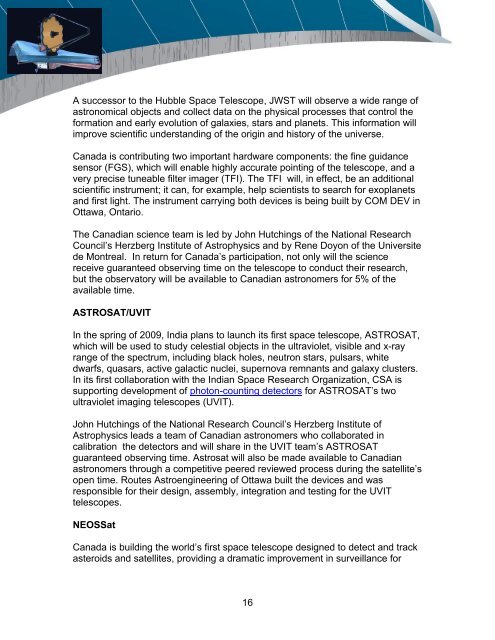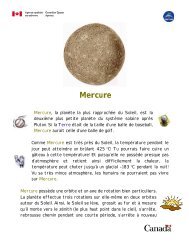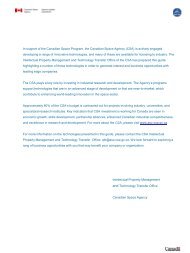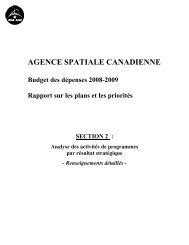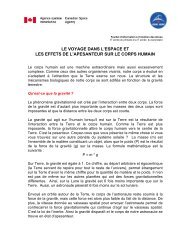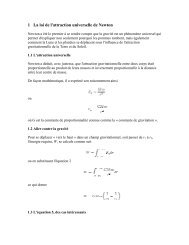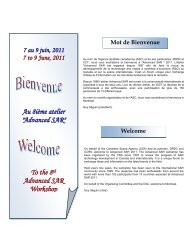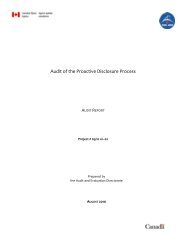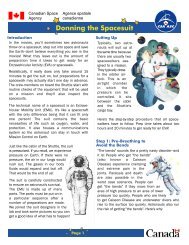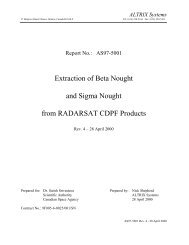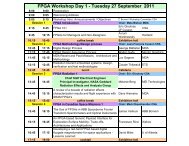PDF version of COSPAR - Space Science Research in Canada Report
PDF version of COSPAR - Space Science Research in Canada Report
PDF version of COSPAR - Space Science Research in Canada Report
You also want an ePaper? Increase the reach of your titles
YUMPU automatically turns print PDFs into web optimized ePapers that Google loves.
A successor to the Hubble <strong>Space</strong> Telescope, JWST will observe a wide range <strong>of</strong>astronomical objects and collect data on the physical processes that control theformation and early evolution <strong>of</strong> galaxies, stars and planets. This <strong>in</strong>formation willimprove scientific understand<strong>in</strong>g <strong>of</strong> the orig<strong>in</strong> and history <strong>of</strong> the universe.<strong>Canada</strong> is contribut<strong>in</strong>g two important hardware components: the f<strong>in</strong>e guidancesensor (FGS), which will enable highly accurate po<strong>in</strong>t<strong>in</strong>g <strong>of</strong> the telescope, and avery precise tuneable filter imager (TFI). The TFI will, <strong>in</strong> effect, be an additionalscientific <strong>in</strong>strument; it can, for example, help scientists to search for exoplanetsand first light. The <strong>in</strong>strument carry<strong>in</strong>g both devices is be<strong>in</strong>g built by COM DEV <strong>in</strong>Ottawa, Ontario.The Canadian science team is led by John Hutch<strong>in</strong>gs <strong>of</strong> the National <strong>Research</strong>Council’s Herzberg Institute <strong>of</strong> Astrophysics and by Rene Doyon <strong>of</strong> the Universitede Montreal. In return for <strong>Canada</strong>’s participation, not only will the sciencereceive guaranteed observ<strong>in</strong>g time on the telescope to conduct their research,but the observatory will be available to Canadian astronomers for 5% <strong>of</strong> theavailable time.ASTROSAT/UVITIn the spr<strong>in</strong>g <strong>of</strong> 2009, India plans to launch its first space telescope, ASTROSAT,which will be used to study celestial objects <strong>in</strong> the ultraviolet, visible and x-rayrange <strong>of</strong> the spectrum, <strong>in</strong>clud<strong>in</strong>g black holes, neutron stars, pulsars, whitedwarfs, quasars, active galactic nuclei, supernova remnants and galaxy clusters.In its first collaboration with the Indian <strong>Space</strong> <strong>Research</strong> Organization, CSA issupport<strong>in</strong>g development <strong>of</strong> photon-count<strong>in</strong>g detectors for ASTROSAT’s twoultraviolet imag<strong>in</strong>g telescopes (UVIT).John Hutch<strong>in</strong>gs <strong>of</strong> the National <strong>Research</strong> Council’s Herzberg Institute <strong>of</strong>Astrophysics leads a team <strong>of</strong> Canadian astronomers who collaborated <strong>in</strong>calibration the detectors and will share <strong>in</strong> the UVIT team’s ASTROSATguaranteed observ<strong>in</strong>g time. Astrosat will also be made available to Canadianastronomers through a competitive peered reviewed process dur<strong>in</strong>g the satellite’sopen time. Routes Astroeng<strong>in</strong>eer<strong>in</strong>g <strong>of</strong> Ottawa built the devices and wasresponsible for their design, assembly, <strong>in</strong>tegration and test<strong>in</strong>g for the UVITtelescopes.NEOSSat<strong>Canada</strong> is build<strong>in</strong>g the world’s first space telescope designed to detect and trackasteroids and satellites, provid<strong>in</strong>g a dramatic improvement <strong>in</strong> surveillance for16


